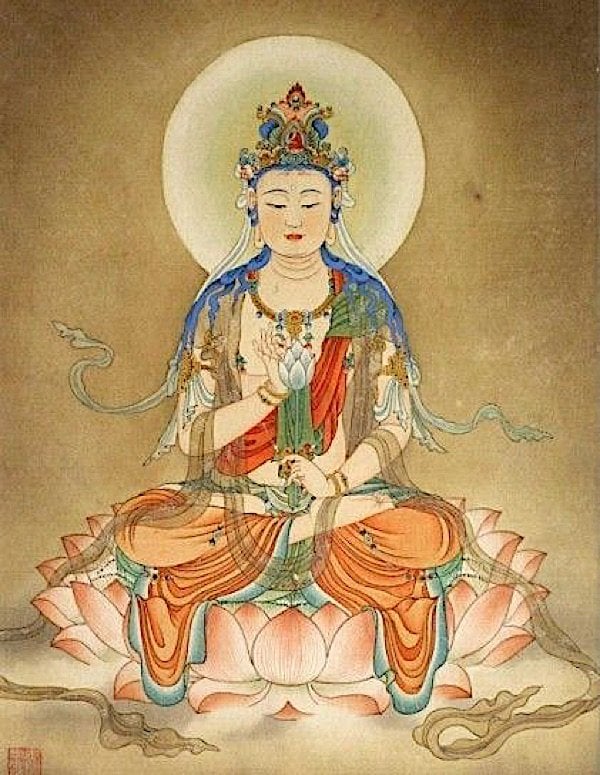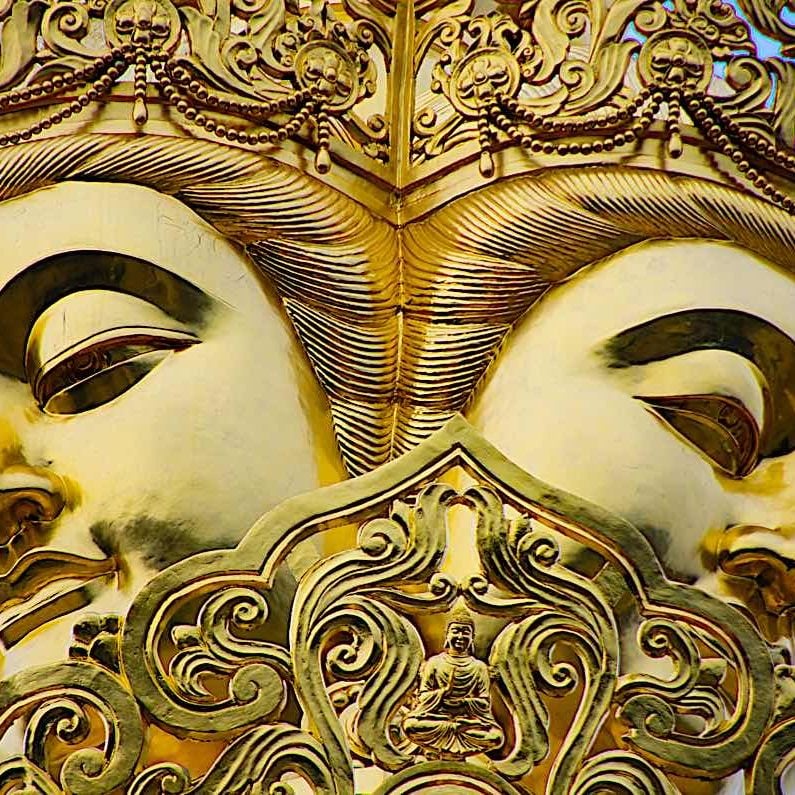Devoted to compassion: How the practice of Guanyin Avalokiteshvara is powerful, healing, liberating and precious
Guanyin is often referred to as the “most widely beloved Buddhist Divinity.”[2] Why? Because Her love is unconditional, all-embracing, and She will never cease her merciful activity until all beings are rescued from Samsara’s suffering. So all-encompassing is Her compassion that she appears in at least 108 forms — male, female, wrathful, peaceful, two-armed or multi-armed — all are the faces of compassion.

Guanshiyin Bodhisattva — Compassion embodied
Guanshiyin Bodhisattva’s popularity and forms eclipse any dualistic attempts to define Her/Him. Venerable Master Hsuan Hua explains why it is so difficult to define the embodiment of compassion:
“In Buddhism, he appears as a Bodhisattva; in other religions he often appears clad in white robes. In Christianity, he is the Holy Mother; he appears as the Holy Mother to teach and transform a certain category of beings … He fills empty space and pervades the Dharma Realm; he is in every place and yet not in any place. He appears according to what kind of body is needed to save each particular category of beings… Guanshiyin Bodhisattva is not necessarily male or female… These are the endless miraculous functions and inconceivable states of Guanshiyin Bodhisattva.”[5]
Her/his most famous form, as 1000-armed, 11-faced Guanyin Avalokiteshvara —known as Avalokiteśvara-ekadaśamukha — iconic of the “many faces of Compassion, associated with her most popular and famous Dharani (chanted in the video below by Buddha Weekly’s volunteers!).
This form combines all the forms of Guanyin Avalokiteshvara into one — with 1000 symbolic arms reaching out to help all beings who are suffering or need protection. Chanting his most famous Dharani (from Sutra, no empowerment required) is a fast way to invoke his/her blessing and protection
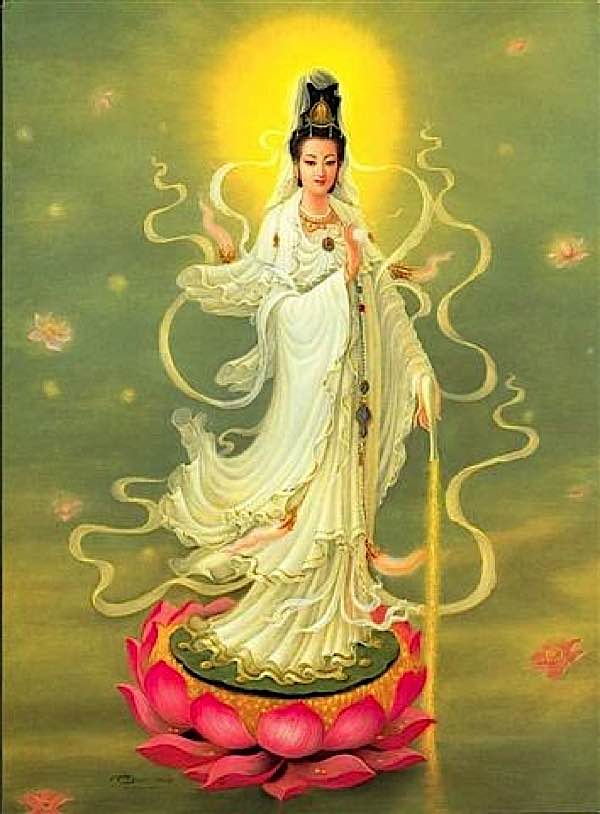
The “Star” of Buddhism
Buddhism is not about personalities, ego and popularity — but if there was a “popularity contest” — Guanyin (Kuan yin, Guanshiyin, Kuanyin, Avalokiteshvara, Kannon) would undoubtedly have the biggest devotional fan base.

It’s a terrible metaphor, but it illustrates Her/His unrivaled compassionate activity in our suffering world. Guanyin’s hit song would be the Heart Sutra. And, just to demonstrate her all-inclusive compassionate nature, she appears on stage as female or male (hence the Her/His above), and countless forms: Holy savior, compassionate Bodhisattva, active Protector, 1000-armed miracle — and even ferocious or wrathful.
Buddha Weekly documentary on how Guanyin saves from the 10 great fears and dangers:
No representation of Enlightenment is more loving or compassionate. No Bodhisattva is more active. The great Mahayana Vehicle — that rescue vehicle that hopes to rescue all suffering beings, not just a few — is exemplified in Avalokiteshvara Guanyin. The two most important concepts in Mahayana Buddhism are Compassion and Wisdom — and Guanyin embraces both.
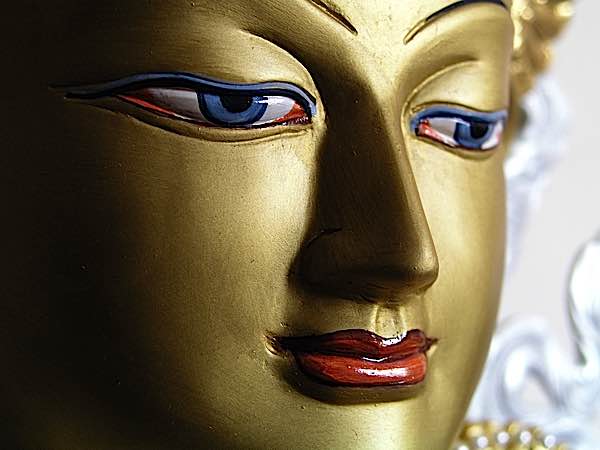
All-Embracing Love
Robert Thurman explains why Avalokiteshvara is so popular around the world: “…in a sense, Avalokiteshvara is even more than a buddha. After attaining buddhahood, he voluntarily returned to the way of a bodhisattva in order to lead all beings to buddhahood.” [3]
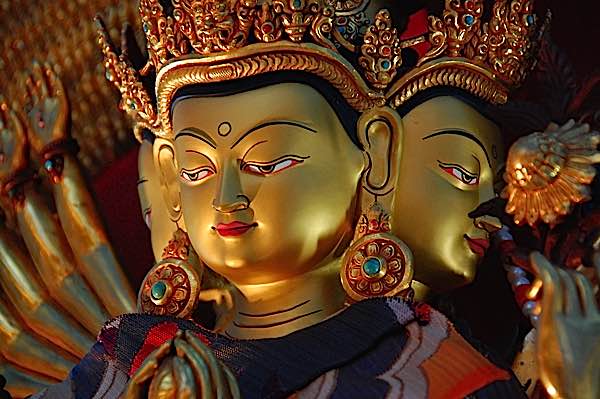
Symbolically, Guanyin Avalokiteshvara appears as both male and female: male representing compassion and female representing compassion. Her power is so all-embracing and loving, that she manifests in endless ways to help us.
Guanyin Avalokeshvara does not ask for devotion, nor require it, but her all-embracing Metta and Karuna (Love and Compassion) make her among the most loved face of Enlightenment.
One way to feel the compassionate love and power of Guanyin is to chant Namo Guanshiyin Pusa (Pusa means Bodhisattva):
Feel the love
Whoever simply looks at her loving, gentle face — even a non-Buddhist — feels instant love, warmth, and peace. Simply that. Gaze upon the loving face of any of her peaceful representations. It’s a proven method for relaxation and stress-reduction. [See this feature>>]
Even her descriptive titles are soothing and inspiring:
Goddess of Mercy (A title given Her by Christian Jesuit missionaries in China.)
She Who Hears the Cries of the World (More or less a translation of Her name.)
The Lord Who Looks in Every Direction
Bodhisattva of Compassion
Guanyin: Right Dharma Brightness
So perfect is Guanyin that she also arises in the Daoist pantheon and a key figure of worship. How, then, can we define the undefinable? Venerable Hsuan Hua, in a Dharma talk, explains:
” Guanshiyin Bodhisattva already became a Buddha a long time ago, by the name of Right Dharma Brightness. He simply appears as a Bodhisattva in order to teach and transform living beings…
“Guanshiyin Bodhisattva uses kindness, compassion, joy, and giving to save all living beings. He saves beings from the seven difficulties, responds to two kinds of seeking, has fourteen kinds of fearlessness, speaks Dharma in nineteen ways, and has thirty-two response bodies.”
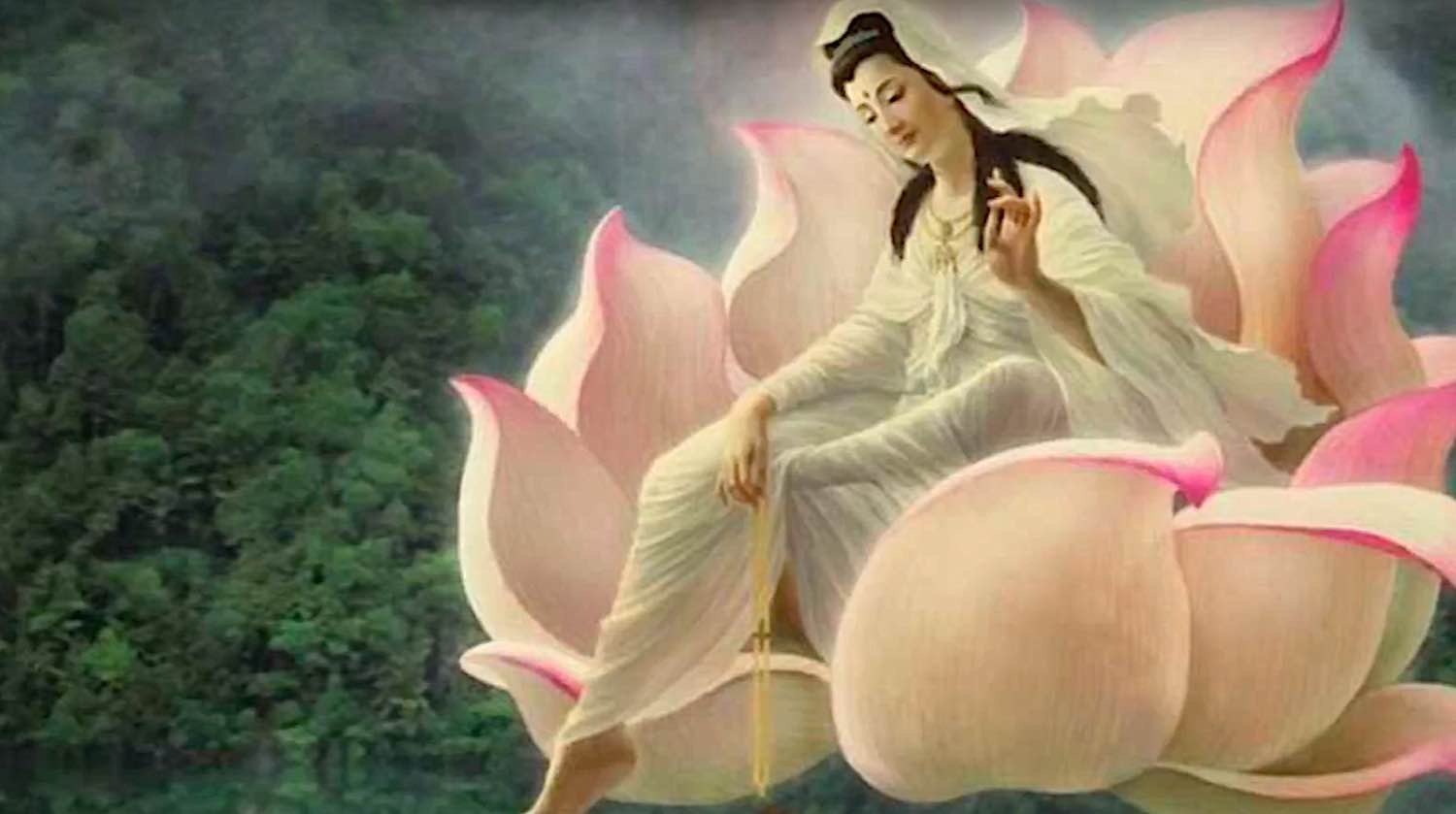
Guanyin Appears in Countless Forms
In the Lotus Sutra, Avalokiteshvara is described as the Bodhisattva who can take any form, including all Gods, Buddhas, and Heavenly Beings, or even humans or animals. Of the thirty-three manifestations of Guanyin listed in the Lotus Sutra, seven are female. From the sutra:
“The Buddha said to Bodhisattva Inexhaustible Intent: “Good man, if there are living beings in the land who need someone in the body of a Buddha in order to be saved, Bodhisattva Perceiver of the World’s Sounds immediately manifests himself in a Buddha body and preaches the Law for them. If they need someone in a pratyekabuddha’s body in order to be saved, immediately he manifests a pratyekabuddha’s body and preaches the Law to them. If the need a voice-hearer to be saved, immediately he becomes a voice-hearer and preaches the Law for them. If they need King Brahma to be saved, immediately he becomes King Brahma and preaches the Law for them. If they need the lord Shakra to be saved, immediately he becomes the lord Shakra and preaches the Law for them. If they need the heavenly being Freedom to be saved, immediately he becomes the heavenly being Freedom and preaches the Law for them. If they need a great general of heaven to be saved, immediately he becomes a great general of heaven and preaches the Law for them. If they need Vaishravana to be saved, immediately he becomes Vaishravana and preaches the Law for them. If they need a petty king to be saved, immediately he becomes a petty king and preaches the law for them.”
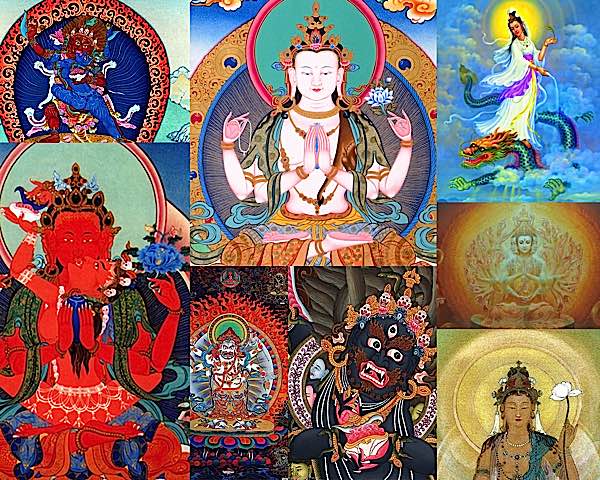
Where is Guanyin?
Venerable Master Hsuan Hua explains Guanyin is in every heart, in every home. More specifically, the Venerable teacher describes where we can find the loving Bodhisattva:
“Well, then, where does he come from? He fills empty space and pervades the Dharma Realm; he is in every place and yet not in any place. He appears according to what kind of body is needed to save each particular category of beings. He manifests in whatever physical form is appropriate to speak Dharma for beings; thus his identity is flexible. Guanshiyin Bodhisattva appears in the form of a Buddha to save those who are ready to become Buddhas. He appears as a Bodhisattva to save those who should become Bodhisattvas. He appears as a heavenly king to speak Dharma for beings in the heavens.”[5]
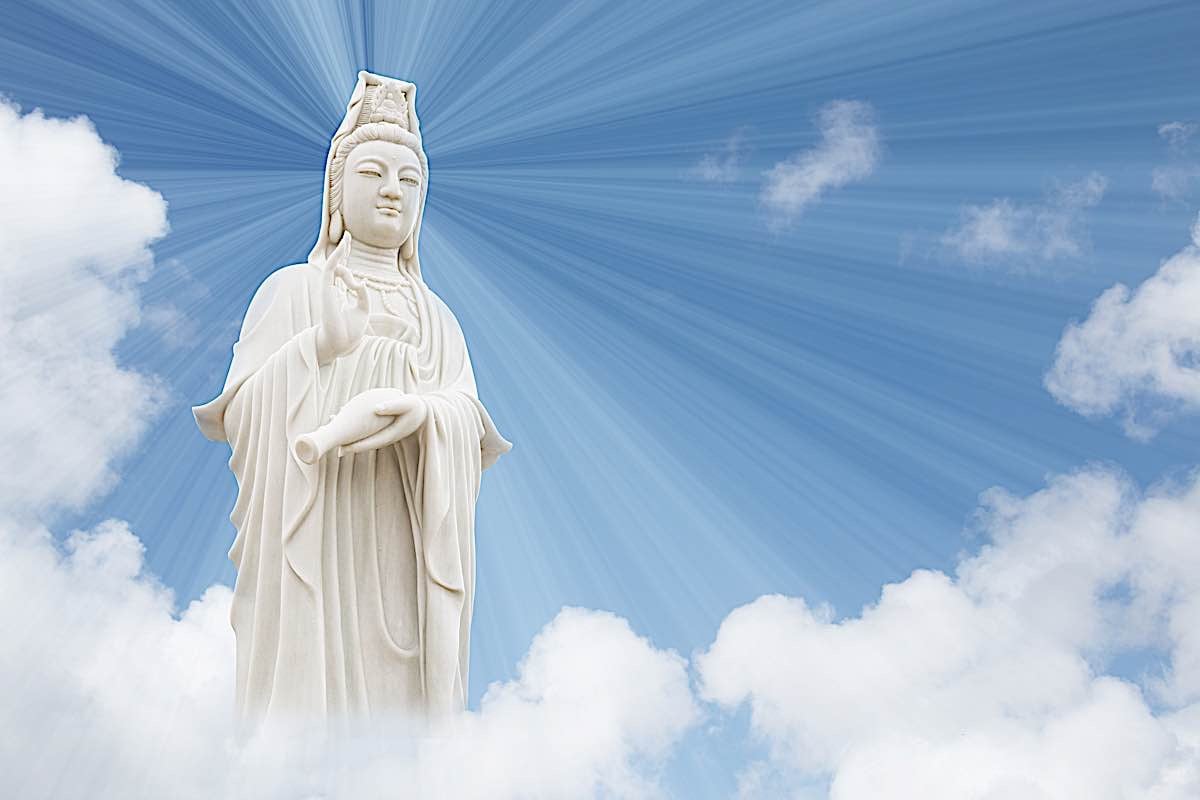
Thinking of Guanyin is Enough to Save Beings
In the Lotus Sutra, chapter 25, Buddha explains:
World-Honored One replete with wonderful features,
I now ask you once again
for what reason that Buddha’s son
is named Bodhisattva Perceiver of the World’s Sounds?
The honored One endowed with wonderful features
replied to Inexhaustible Intent in verse:
Listen to the actions of the Perceiver of Sounds,
how aptly he responds in various quarters.
His vast oath is deep as the ocean;
kalpas pass but it remains unfathomable.
He has attended many thousands and millions of Buddhas,
setting forth his great pure vow.
I will describe him in outline for you-
listen to his name, observe his body,
bear him in mind, not passing the time vainly,
for he can wipe out the pains of existence.
Suppose someone should conceive a wish to harm you,
should push you into a great pit of fire.
Think on the power of that Perceiver of Sounds
and the pit of fire will change into a pond!
If you should be cast adrift on the vast ocean,
menaced by dragons, fish and various demons,
think on the power of that Perceiver of Sounds
and the billows and waves cannot drown you!
Suppose you are on the peak of Mount Sumeru
and someone pushes you off.
Think on the power of that Perceiver of Sounds
and you will hang in midair like the sun!
Suppose you are pursued by evil men
who wish to throw you down from a diamond mountain.
Think on the power of that Perceiver of Sounds
and they cannot harm a hair of you!
Suppose you are surrounded by evil-hearted bandits,
each brandishing a knife to wound you.
Think on the power of that Perceiver of Sounds
and at once all will be swayed by compassion!
Suppose you encounter trouble with the king’s law,
face punishment, about to forfeit your life.
Think on the power of that Perceiver of Sounds
and the executioner’s sword will be broken to bits!
Suppose you are imprisoned in cangue and lock,
hands and feet bound by fetters and chains.
Think on the power of that Perceiver of Sounds
and they will fall off, leaving you free!
Suppose with curses and various poisonous herbs
someone should try to injure you.
Think on the power of that Perceiver of Sounds
and the injury will rebound upon the originator.
Suppose you encounter evil rakshasas,
poison dragons and various demons.
Think on the power of that Perceiver of Sounds
and then none of them will dare to harm you.
If evil beasts should encircle you,
their sharp fangs and claws inspiring terror,
think on the power of that Perceiver of sounds
and they will scamper away in boundless retreat.
If lizards, snakes, vipers, scorpions
threaten you with poison breath that sears like flame,
think on the power of that Perceiver of Sounds
and, hearing your voice, they will flee of themselves.
If clouds should bring thunder, and lightning strike,
if hail pelts or drenching rain comes down,
think on the power of that Perceiver of Sounds
and at that moment they will vanish away.
If living beings encounter weariness or peril,
immeasurable suffering pressing them down,
the power of the Perceiver of Sounds’ wonderful wisdom
can save them from the sufferings of the world.
He is endowed with transcendental powers
and widely practices the expedient means of wisdom.
Throughout the lands in the ten directions
there is no region where he does not manifest himself.
In many different kinds of evil circumstances,
in the realms of hell, hungry spirits or beasts,
the sufferings of birth, old age, sickness and death–
all these he bit by bit wipes out.
He of the true gaze, the pure gaze,
the gaze of great and encompassing wisdom,
the gaze of pity, the gaze of compassion–
constantly we implore him, constantly look up in reverence.
His pure light, free of blemish,
is a sun of wisdom dispelling all darknesses.
He can quell the wind and fire of misfortune
and everywhere bring light to the world.
The precepts from his compassionate body shake us
like thunder,
the wonder of his pitying mind is like a great cloud.
He sends down the sweet dew, the Dharma rain,
to quench the flames of earthly desires.
When law suits bring you before the officials,
when terrified in the midst of an army,
think on the power of that Perceiver of Sounds
and hatred in all its forms will be dispelled.
Wonderful sound, Perceiver of the World’s Sounds,
Brahma’s sound, the sea tide sound–
they surpass those sounds of the world;
therefore you should constantly think on them
from thought to thought never entertaining doubt!
Perceiver of the World’s Sounds, pure sage–
to those in suffering, in danger of death,
he can offer aid and support.
Endowed with all benefits,
he views living beings with compassionate eyes.
The sea of his accumulated blessings is immeasurable;
therefore you should bow your head to him!

The # 1 Hit: The Heart Sutra
Guanyin Avalokteshvara is mentioned in more Mahayana sutras than any other Enlightened Being.
In the hit song mentioned, The Heart Sutra — the “single most commonly recited, copied and studied scripture in East Asian Buddhism”[1] — Guanyin teaches the “Perfection of Wisdom”:
Form is Emptiness. Emptiness is Form
Emptiness, not to be confused with nothingness, is anchored in Buddha’s doctrine of Dependent Origination. The Heart Sutra is a profound teaching that frees us from fear, and helps us understand the inter-connectedness of all beings.
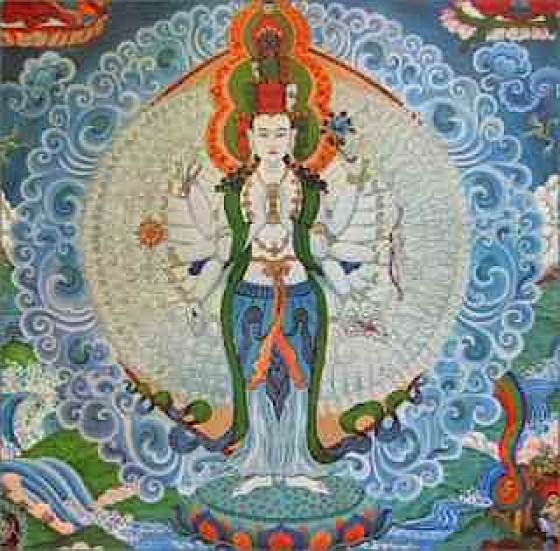
Guanyin Avalokiteshvara is especially praised in The Lotus Sūtra (Sanskrit Saddharma Puṇḍarīka Sūtra), notably in the 25th Chapter. [See our feature Avalokiteshvara: delivering us from every danger, Chapter 25 of Lotus Sutra.]
In the Lotus Sutra, the merits of Avalokiteshvara are described in great detail, every possible danger listed, and how the Bodhisattva can save us. It is summarized in verse:
Perceiver of the World’s Sounds, pure sage—
to those in suffering, in danger of death,
He can offer aid and support.
Endowed with all benefits,
He views living beings with compassionate eyes.
The sea of his accumulated blessings is immeasurable;
therefore you should bow your head to him!
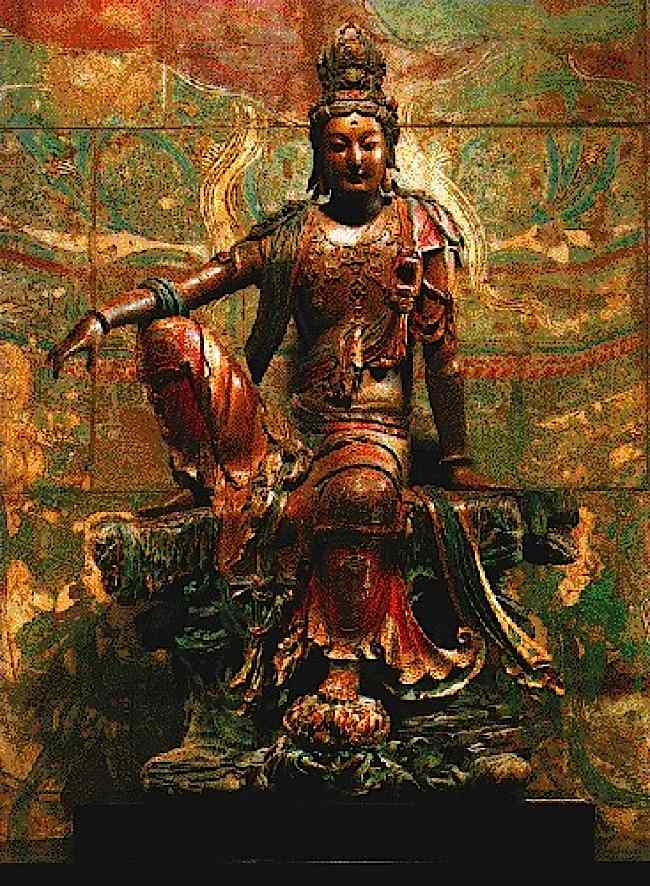
How to Ask for Guanyin’s Help
Thich Nhat Hanh explains how to awaken the energy of Avaolokiteshvara:
“Calling the name of Avalokiteshvara is one of the ways to awaken the energy of compassion in your heart.”
In the Lotus Sutra, Shakyamuni Buddha describes how to invoke the aid of the Compassionate Bodhisattva:
‘Hail to the Bodhisattva Perceiver of the World’s Sounds!’ And because they call his name, they are at once able to gain deliverance.
It’s literally that simple.

Praising the Loving One — Guanyin
The various ways to praise His/Her name are:
Sanskrit
- Namo Avalokiteshvara
- Various forms of Chinese (slight variants)
- Namo Gwan Yin Pu Sa
- Namo Kuanyin Pu Sa
- Namo Guan Yim
- Namo Kuan Yim
- Namo Kuan Yin
Other variants (Namo in all cases here is Sanskrit for simplicity)
- Namo Chenrezig (Chenrezik Tibetan སྤྱན་རས་གཟིགས)
- Namo Gwan-eum (Korean: 관세음)
- Namo Kanzeon (観世音) or Namo Kannon (観音) (Japanese)
- Namo Kuan Im (Thai กวนอิม)
- Namo Quán Thế Âm (Vietnamese)
- Namo to the Bodhisattva Perceiver of the World’s Sounds! (English)
Mantra of Avalokiteshvara “Om Mani Padme Hum” chanted 108 times by the amazing Yoko Dharma with beautiful meditative images:
Mantras of Avalokiteshvara
Om Mani Padme Hum
[For a video chant of Om Mani Padme Hum see>>]
On aruri kya sowa ka
(Shingon) in Japanese おん あるりきゃ そわか
Great Compassionate Dharani of Avalokiteshvara-Edandashamukha in Sanskrit
(chanted in the video above!)
Namo Ratna Trayaya
Nama Arya Jyana
Sagara Vairochana
Byuhara Jaya Tathagataya
Arahate Samyaksam Buddhaya
Namah Sarwa Tathagate Bhyayh Arahatda Bhayh
Samyaksam Buddhe Bhayh
Namah Arya Awalokite
Shoraya Bohisatwaya
Mahasatwaya
Maha Karunikaya
Tatyata Om Dhara Dhara
Dhiri Dhiri
Dhuru Dhuru
Iti Wit Je Chalee Chalee
Purachale Purachale
Kusume Kusama Wa Re
Ili Mili Chiti
Jwala Mapanaya Soha
[For video chant version of the Great Compassion Mantra, see>>]

Guanyin’s Special Day
Each year, Guanyin’s compassionate activities is celebrated on the 19th day of the 6th Lunar month — traditionally the anniversary of the day Guan Shi Yin attained Buddhahood (Enlightenment.) [4]
Her sacred place is Mount Puo Tu [普陀山].
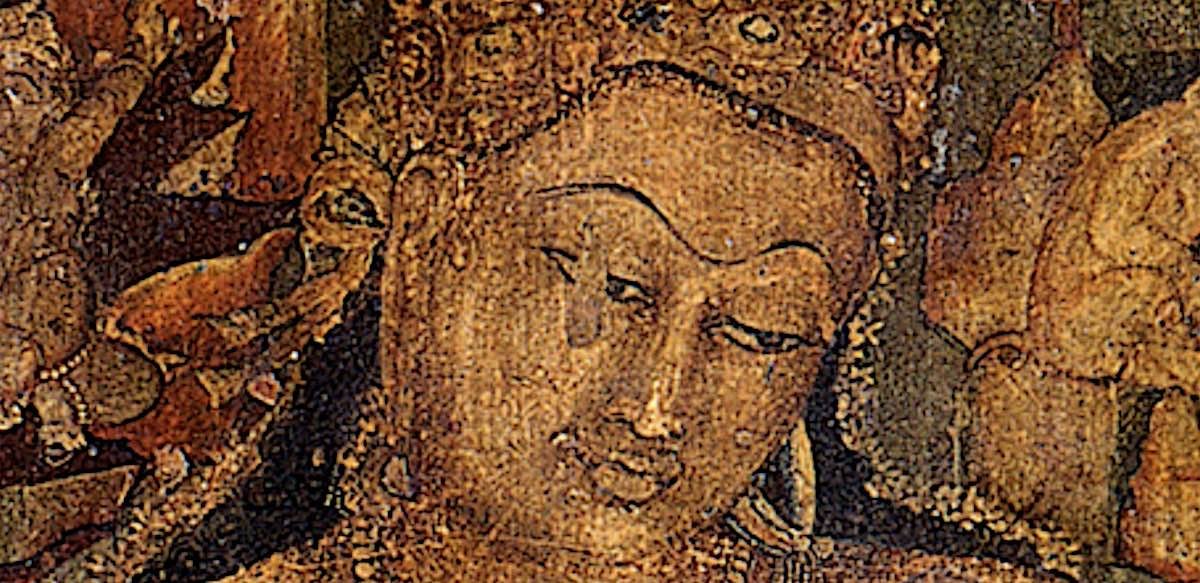
Other Sutras Featuring Avalokiteshvara
Although the Lotus Sutra is the first and best-known sutra honoring the compassionate Buddha, there are many others, including, of course, the Heart Sutras where he teaches his realizations on Shunyata (Emptiness). Some texts which mention Avalokiteśvara include:
- Avataṃsaka Sūtra
- Cundī Dhāraṇī Sūtra
- Eleven-Faced Avalokitesvara Heart Dharani Sutra
- Heart Sutra (Heart Sūtra)
- Longer Sukhāvatīvyūha Sūtra
- Lotus Sutra
- Kāraṇḍavyūhasūtra
- Karuṇāpuṇḍarīka sūtram
- Nīlakaṇṭha Dhāraṇī Sutra
- Śūraṅgama Sūtra
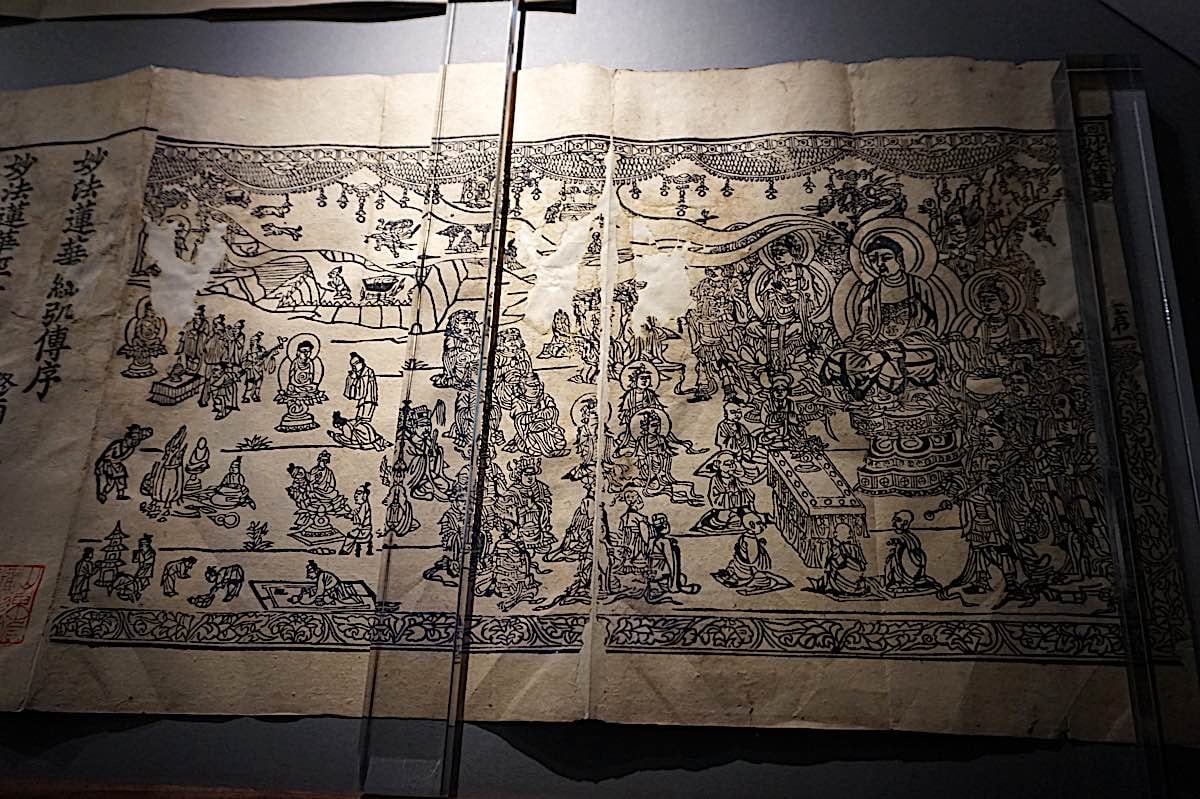
Other Sutras Featuring Avalokiteshvara
In the Kangyur there is the Sutra featuring the 108 names of Avalokiteshvara, starting with number one with the wrathful form of Guanyin, Hayagrivalokeshvara, or Hayagriva Avalokiteshvara. For a feature on Hayagriva, see>>
- Don’t miss our video documentary on Hayagriva on our Youtube channel here>>
Wrathful form of Hayagriva, documentary:
Other names of Guanyin Avalokiteshvara
Avalokiteshvara Guanyin is called by many names in different countries:
- Cantonese: Gwun Yam or Gun Yam, also written as Kwun Yam in Hong Kong or Kun Iam in Macau.
- Tibetan: Chenrézik (སྤྱན་རས་གཟིགས) Chenrezig, Chenresig
- Japanese, Guanyin is pronounced Kannon (観音), occasionally Kan’on, or more formally Kanzeon (観世音, the same characters as Guanshiyin)
- Korean, Guanyin is called Gwan-eum (Korean: 관음) or Gwanse-eum (Korean: 관세음)
- Hokkien: Kuan Im (POJ: Koan-im) or Kuan Se Im (POJ: Koan-sè-im)
- Khmer: Preah Mae Kun Si Im. (ព្រះម៉ែ គង់សុីអុិម). She is also called Preah Neang Kun Si Im (ព្រះនាង[princess] គង់សុីអុិម). The word “Preah” is God/Goddess and “Mae” is Mother
- Thai: Kuan Im (กวนอิม), Phra Mae Kuan Im (พระแม่กวนอิม; Phra Mae means “goddess”) or Chao Mae Kuan Im (Thai: เจ้าแม่กวนอิม; Chao Mae usually means “madam”, but in this terms, means “goddess”).
- Burmese: Kwan Yin Medaw, literally meaning Mother Kwan Yin (Goddess Guanyin) (ကွမ်ယင်မယ်တော်).
- Vietnamese: Quan Âm or Quan Thế Âm.
- Indonesian: is Kwan Im or Dewi Kwan Im. She is also called Mak Kwan Im “Mother Guanyin”.
- Malaysian Mandarin: GuanYin Pusa (GuanYin Bodhisattva), Guan Shi Yin Pusa (GuanYin Bodhisattva).
- Sinhala: Natha Deviyo (නාථ දෙවියෝ).
- Hmong, the name is Kab Yeeb.
- Nepali, the name is Seto Machindranath
NOTES
[1] McRae, John (2004), “Heart Sutra”, in Buswell, Jr., Robert E. (ed.), Encyclopedia of Buddhism, MacMillan
[2] Avalokteshvara feature on Britannica. https://global.britannica.com/topic/bodhisattva
[3] “Avalokiteshvara in Tibet”, Tricycle
[4] “Bodhisattva Guan Shi Yin’s Attainment of Buddhahood 觀世音菩薩成佛 – Purple Cloud”.
[5] Guanyin, Guanyin, Guanshiyin: Venerable Master Hsuan Hua http://www.cttbusa.org/dharmatalks/guanyin.htm
More articles by this author
Search
Latest Features
Please support the "Spread the Dharma" mission as one of our heroic Dharma Supporting Members, or with a one-time donation.
Please Help Support the “Spread the Dharma” Mission!

Be a part of the noble mission as a supporting member or a patron, or a volunteer contributor of content.
The power of Dharma to help sentient beings, in part, lies in ensuring access to Buddha’s precious Dharma — the mission of Buddha Weekly. We can’t do it without you!
A non-profit association since 2007, Buddha Weekly published many feature articles, videos, and, podcasts. Please consider supporting the mission to preserve and “Spread the Dharma." Your support as either a patron or a supporting member helps defray the high costs of producing quality Dharma content. Thank you! Learn more here, or become one of our super karma heroes on Patreon.
Lee Kane
Author | Buddha Weekly
Lee Kane is the editor of Buddha Weekly, since 2007. His main focuses as a writer are mindfulness techniques, meditation, Dharma and Sutra commentaries, Buddhist practices, international perspectives and traditions, Vajrayana, Mahayana, Zen. He also covers various events.
Lee also contributes as a writer to various other online magazines and blogs.








